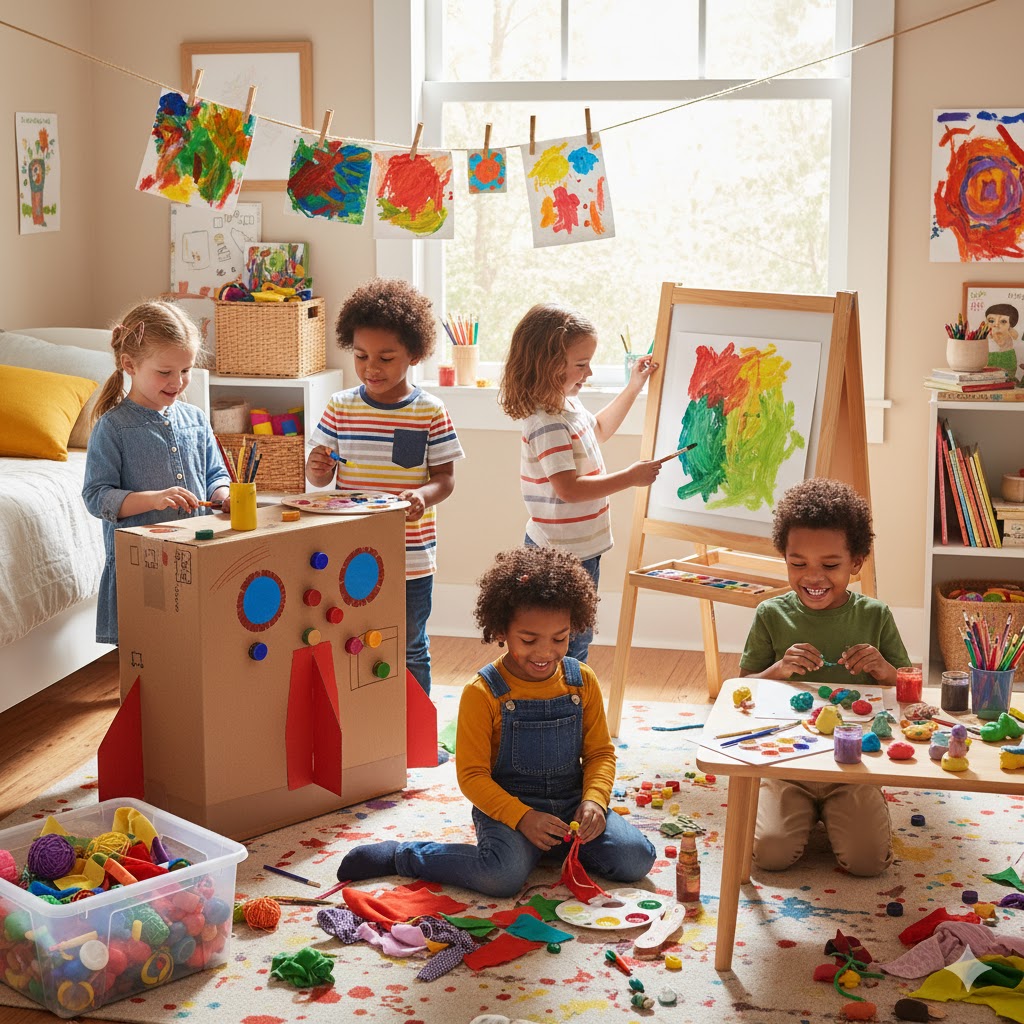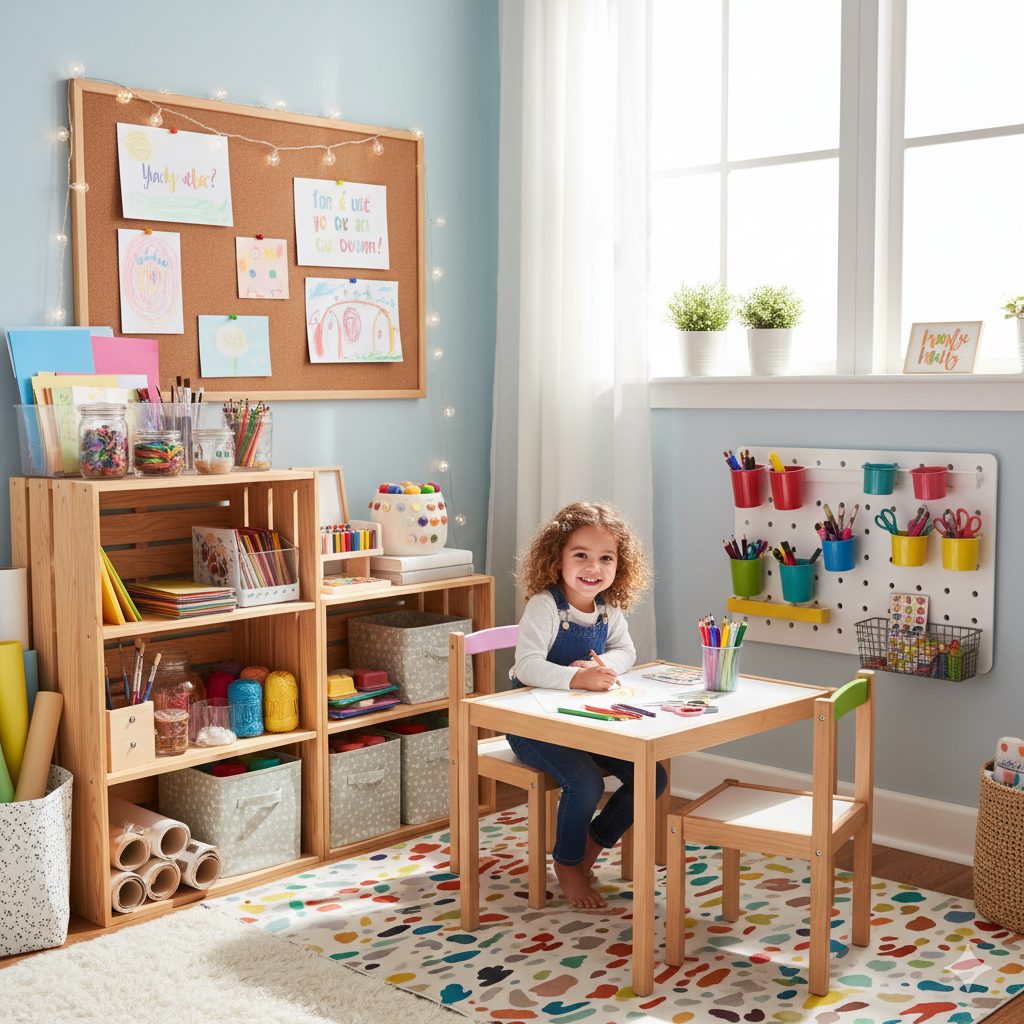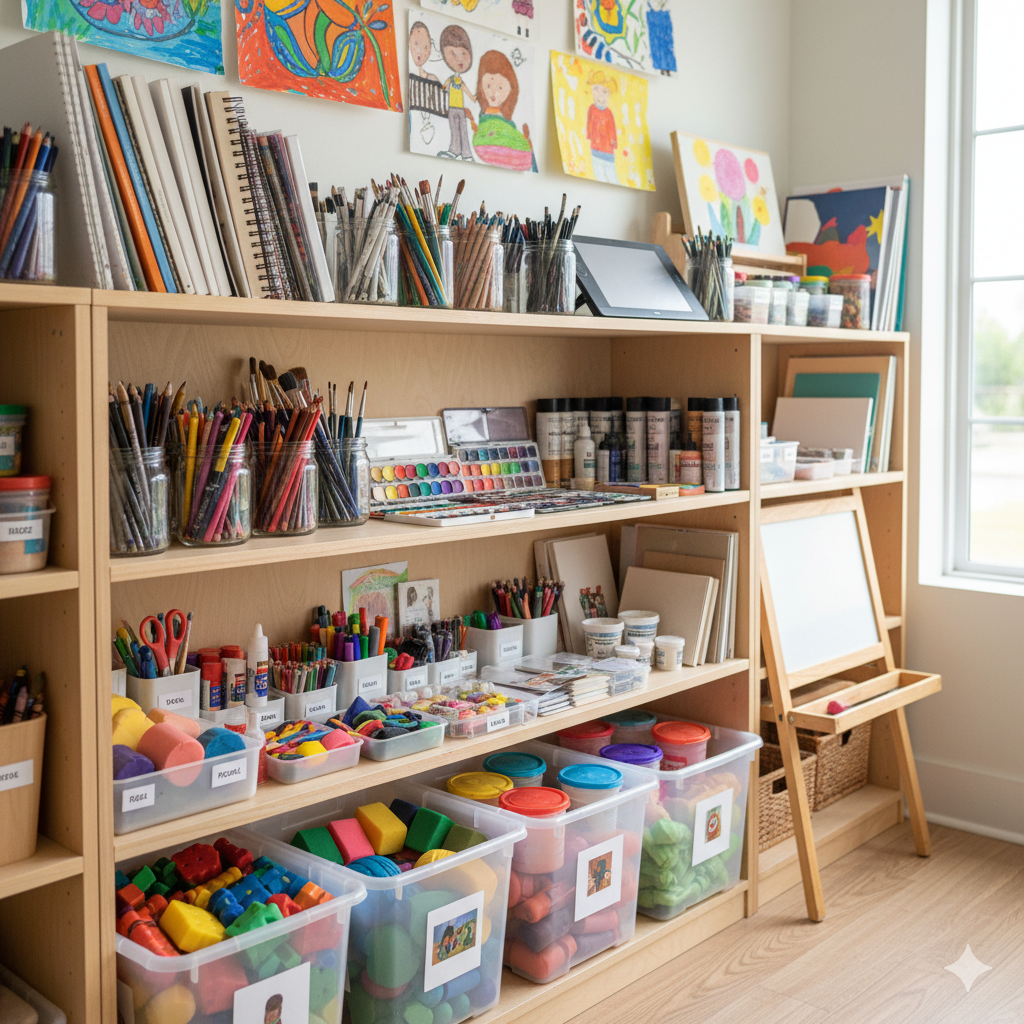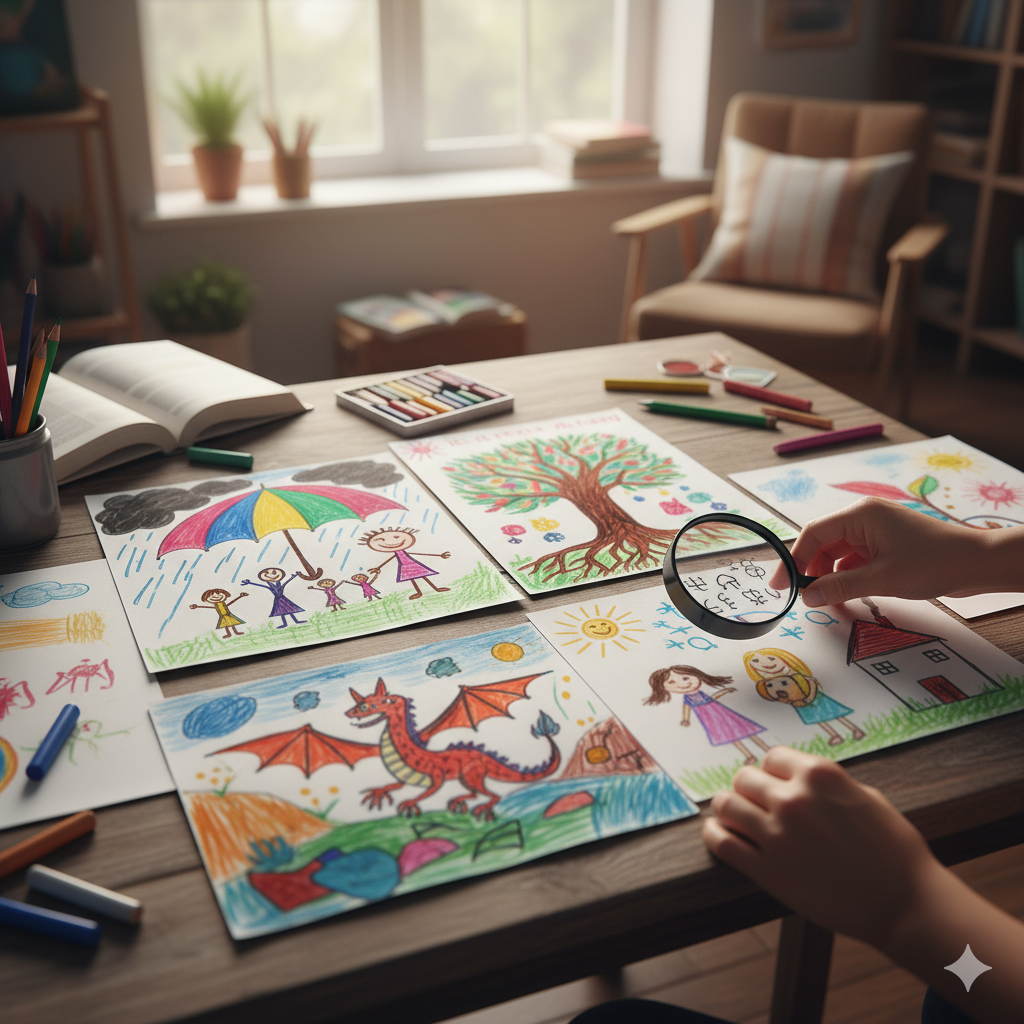10 Ways to Encourage Your Child's Creative Development
Last week, I watched my seven-year-old daughter transform a simple cardboard box into a spaceship, complete with control panels made from bottle caps and a windshield drawn with markers. As she explained her design choices with the enthusiasm of a NASA engineer, I was reminded of something profound: creativity isn't just about producing beautiful artwork—it's about developing the problem-solving abilities, critical thinking, and confidence that will serve our children throughout their lives.
As parents, we have this incredible opportunity to nurture our children's natural creative instincts. But here's the thing—it's not about turning them into the next Picasso or making them follow a specific creative path. It's about creating an environment where their imagination can flourish and their unique creative voice can emerge.
1. Give Creativity a Home
When I first decided to create a dedicated art space for my children, I had visions of Pinterest-worthy craft rooms with perfectly organized supplies and matching furniture. Reality? We started with a simple corner in our kitchen, a small table, and some basic supplies in a shoebox. And you know what? It worked beautifully.
The magic isn't in having the perfect setup—it's in sending the message that creativity matters in your home. When children have a space where they can create without worrying about making a mess or being in the way, they're more likely to engage in spontaneous creative activities.
Finding the Right Spot
Look for a location near natural light if possible, away from high-traffic areas where they might feel rushed or interrupted. The space doesn't need to be huge—even a corner can work wonders. What matters most is that it feels like their space, where they can reach materials independently and feel comfortable experimenting.
What Really Matters
Start with the basics: paper, crayons, markers, and colored pencils. Add some storage solutions like clear containers or baskets so children know where everything belongs. Include a display area—even a simple bulletin board or string with clips—so they can showcase their creations. Don't forget comfort items like cushions or a small rug if they prefer working on the floor.
The most important element? Inspiration. Display their artwork, keep art books nearby, and include interesting objects from nature or everyday life that might spark their imagination. I've found that a simple collection of seashells or interesting rocks can inspire hours of creative exploration.
2. Embrace the Beauty of Open-Ended Materials
One of the best lessons I've learned as a parent is the difference between toys that do one thing and materials that can become anything. My daughter's favorite "toy" for months was a simple cardboard tube that became a telescope, a megaphone, a sword, a tunnel for her toy cars, and eventually a rocket ship. That single tube sparked more creativity than any expensive, single-purpose toy ever could.
The Magic of Possibility
Open-ended materials are like blank canvases for the imagination. They have no predetermined use, which means children can use their creativity to decide how to use them. This freedom encourages experimentation, problem-solving, and the kind of deep, focused play that builds real creative thinking skills.
Building Your Creative Arsenal
Start with the basics: various sizes and colors of paper, different drawing tools like crayons, markers, and colored pencils, and some painting supplies. Don't forget modeling materials like clay or play dough—there's something incredibly satisfying about the tactile experience of shaping something with your hands.
But here's where it gets really fun: look around your house for materials that might spark creativity. Cardboard boxes, egg cartons, bottle caps, and fabric scraps can become anything in a child's imagination. Natural objects like leaves, sticks, stones, and shells often inspire the most creative projects.
I keep a "creative treasure box" in our art space filled with interesting objects we find: interesting buttons, colorful ribbons, small containers, and random bits and pieces that might spark an idea. My children love digging through it when they're looking for inspiration.
Sensory Adventures
Don't underestimate the creative potential of sensory materials. Sand, water, rice, beans, and even shaving cream can become incredible creative tools. My son once spent an entire afternoon creating "mountains and rivers" in a tray of sand, complete with tiny figures made from play dough. It was pure creative magic.
3. Focus on Process Over Product
Why Process Matters
When we focus on the creative process rather than the final product, we encourage children to explore without fear, knowing there's no pressure to create something "perfect." This approach helps them learn through experimentation as they try new techniques and approaches without worrying about failure. It also develops their problem-solving skills as they work through challenges independently, and most importantly, it builds confidence by celebrating effort and creativity rather than just results.
How to Emphasize Process
The key is to shift our language and attention. Instead of asking "What is it?" when they show you their artwork, try "Tell me about making this." Praise their effort and creativity with comments like "I love how you experimented with those colors" rather than focusing on the final outcome. Resist the urge to correct their work or tell them how to draw "better." Instead, celebrate what might seem like mistakes by saying "That's interesting! What happens if you try it this way?" You can also document their process by taking photos or videos of them creating, which shows them that the journey is just as valuable as the destination.
Questions That Support Process
When talking about their artwork, ask questions that focus on the creative journey. "What was your favorite part of making this?" helps them reflect on their experience. "How did you decide to use those colors?" encourages them to think about their creative choices. "What would you do differently next time?" promotes planning and reflection. "What did you learn while creating this?" helps them recognize their growth. And "How did you feel while you were making this?" validates the emotional aspect of creativity.
4. Encourage Experimentation and Risk-Taking
Creating a Safe Environment for Experimentation
Children need to feel safe to take creative risks, which means creating an environment where mistakes are celebrated with phrases like "That's a great experiment!" Different approaches are valued by saying "I love how you tried that new way," and uniqueness is appreciated with comments like "Your way of doing this is so creative." Questions should be encouraged by asking "What if you tried...?" to spark their imagination.
Ways to Encourage Risk-Taking
You can support creative risk-taking by providing challenging materials that require problem-solving, asking "what if" questions to encourage them to think of alternatives, and sharing your own creative process so they can see you trying new things. Celebrate what might seem like "failures" by helping them see these as learning opportunities, and offer gentle challenges like "I wonder if you could..." to stretch their thinking.
Examples of Creative Risk-Taking
Creative risk-taking can take many forms. Children might try new materials like watercolors for the first time, or combine unexpected elements like mixing paint with sand. They might break rules by using art supplies in unconventional ways, share their ideas by presenting their work to others, or collaborate with others on creative projects. Each of these represents a step outside their comfort zone and into creative growth.
5. Limit Screen Time and Digital Distractions
The Impact of Screens on Creativity
While technology can be a creative tool, excessive screen time can reduce imaginative play since passive entertainment doesn't encourage active creation. It may also limit problem-solving opportunities because pre-made solutions don't require creative thinking, decrease attention span as quick entertainment doesn't build focus, and reduce social interaction, leaving less time for collaborative creativity.
Creating Screen-Free Creative Time
Establishing boundaries around technology use can help preserve creative time. Designate specific creative hours when screens are off, create screen-free zones in areas where technology isn't allowed, and model screen-free behavior to show children you value offline activities. Make sure creative materials are easily accessible as alternatives, and ensure that creative time feels like play rather than punishment.
Healthy Technology Integration
When you do use technology, make it creative by choosing digital art apps that are tools for creating rather than just consuming. Look for educational content that encourages active participation, creative games that involve building, designing, or problem-solving, and set clear boundaries for screen use. Always choose interactive content over passive consumption to maximize the creative benefits of technology.
6. Read and Explore Art Together
The Connection Between Reading and Creativity
Reading exposes children to new ideas and concepts that expand their mental models, visual storytelling that helps them understand how images convey meaning, different perspectives that allow them to see the world through others' eyes, and rich vocabulary that helps them express their ideas more effectively.
Art Books to Explore Together
Picture books with beautiful illustrations, stories about artists and creativity, books that encourage artistic exploration, and biographies of famous artists can all inspire creative thinking. Art activity books including step-by-step drawing guides, craft and art project books, books about art techniques, and inspiration and idea books provide practical guidance and motivation.
How to Explore Art Together
You can explore art together by visiting museums and galleries, even virtually, looking at art books and discussing what you see and like, creating art inspired by books by drawing characters or scenes, telling stories about art by making up narratives about pictures, and comparing different styles to talk about how artists see things differently.
7. Celebrate Individuality and Unique Expression
Why Individuality Matters
Every child has a unique creative voice. When we celebrate their individuality, we build self-confidence as they feel valued for who they are, encourage authentic expression so they don't feel pressure to copy others, help them develop personal style as they learn to trust their own creative instincts, and foster self-awareness so they understand their own preferences and strengths.
How to Celebrate Individuality
You can celebrate individuality by avoiding comparisons and not comparing their work to others', appreciating their unique style with comments like "I love how you always use bright colors," encouraging personal expression by asking "What do you think about this?," respecting their choices by letting them decide what to create, and documenting their growth by keeping samples to show their personal development.
Questions That Honor Individuality
Ask questions that help them recognize their unique voice: "What makes this special to you?" encourages them to identify what's meaningful. "How is your way different from others?" helps them appreciate their uniqueness. "What do you think makes your art unique?" promotes self-reflection. "What do you like best about your creation?" focuses on their preferences. "How does this show who you are?" connects their art to their identity.
8. Provide Time for Unstructured Creative Play
The Value of Unstructured Time
Unstructured creative play allows children to follow their own interests and explore what genuinely interests them, develop focus as they learn to sustain attention on self-chosen activities, practice decision-making by making choices about what to create, and build intrinsic motivation as they find joy in the creative process itself.
How to Create Unstructured Time
Creating unstructured time involves scheduling free periods with no planned activities, reducing adult direction so children can lead their own play, providing materials but not instructions to let them decide what to do, allowing mess and experimentation without worrying about neatness, and being patient to give them time to get into creative flow.
Signs of Healthy Unstructured Play
You'll know unstructured play is working when children show deep concentration and become absorbed in their activities, demonstrate self-direction by making their own choices about what to do, show persistence by sticking with projects even when they're challenging, display joy and satisfaction as they seem happy and engaged, and show innovation by coming up with new ways to use materials.
9. Connect Creativity to Real-World Applications
Making Creativity Relevant
When children see how creativity applies to real life, they understand its value by seeing why creative thinking matters, feel more motivated as they connect their interests to practical applications, develop problem-solving skills by learning to use creativity to solve real problems, and build confidence as they see themselves as capable of making a difference.
Real-World Creative Applications
Creative skills apply to problem-solving when children design solutions for household challenges, create tools for everyday tasks, invent games for family time, or solve problems in their community. Communication skills develop when they create cards and gifts for others, design presentations for school projects, make visual aids for explaining ideas, or create art to express feelings. Entrepreneurship opportunities arise when they design products to sell at school fairs, create services for family and friends, develop creative business ideas, or learn about marketing and presentation.
How to Make Connections
Help children see the real-world value of creativity by pointing out creative solutions with comments like "That's a creative way to solve that problem," asking for creative input with questions like "How would you design this?," encouraging creative problem-solving by asking "What's another way we could do this?," and celebrating creative contributions by saying "Your idea really helped us."
10. Be a Creative Role Model
The Power of Modeling
Children learn by watching adults. When we model creativity, we show them that creativity is valuable and worth spending time on, how to approach challenges through creative problem-solving in action, that adults make mistakes too and it's okay to try and fail, and that creativity is lifelong and doesn't end in childhood.
Ways to Model Creativity
Share your creative process by letting children see you working on creative projects, talking about your creative decisions and challenges, showing them how you solve creative problems, and sharing your own creative failures and successes. Engage in creative activities together by working on projects side by side, collaborating on creative challenges, sharing ideas and inspiration, and celebrating each other's creative efforts. Demonstrate creative thinking by thinking out loud when solving problems, showing different ways to approach challenges, asking creative questions in everyday situations, and modeling curiosity and wonder about the world.
Creative Activities to Do Together
You can engage in creative activities together through cooking by experimenting with recipes and ingredients, gardening by designing and planting creative gardens, home improvement by decorating and organizing spaces creatively, crafting by working on projects that require creative problem-solving, music by creating songs or rhythms together, and storytelling by making up stories and characters together.
Creating a Creative Family Culture
Family Rituals That Support Creativity
Create family rituals that support creativity by establishing art nights for regular family creative time, organizing show and tell sessions for sharing creative projects with each other, planning creative challenges through family competitions or collaborations, setting aside time for inspiration sharing by talking about what inspires each person, and holding creative celebrations to honor creative achievements.
Building a Creative Community
Build a creative community by connecting with other creative families to share ideas and inspiration, participating in community art events and joining local creative activities, supporting local artists by visiting galleries and attending performances, sharing your children's work by displaying and celebrating their creativity, and creating a creative network by building relationships with other creative people.
Conclusion
Encouraging your child's creative development is one of the most rewarding investments you can make as a parent. By creating a supportive environment, providing the right materials, and modeling creative behavior, you're helping your child develop skills that will serve them throughout their lives.
Remember that creativity isn't just about producing beautiful artwork—it's about developing the ability to think differently, solve problems innovatively, and express oneself authentically. Every child is naturally creative, and our job as parents is to nurture and support that creativity rather than inadvertently stifling it.
The most important thing is to keep the focus on the process of creation rather than the final product. When children feel free to explore, experiment, and express themselves without fear of judgment, they develop the confidence and skills that will serve them in all areas of life.
Start with one or two of these strategies and gradually incorporate more as they become natural parts of your family life. The key is consistency and genuine enthusiasm for your child's creative journey. When you show that you value creativity, your children will too.
Want to see how your child's creative development is progressing? Our AI-powered analysis tool can provide insights into the artistic techniques, creative expression, and developmental patterns in your child's drawings. Try our child drawing analysis tool to discover what your child's artwork reveals about their creative growth.
---
Remember: Every child develops creativity at their own pace. The goal is to support and encourage their natural creative instincts, not to push them toward specific outcomes or compare them to others.



